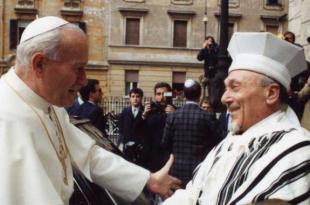
Unknown (public domain), Pope John Paul II meeting Rabbi Elio Toaff, Chief Rabbi of Rome, at The Great Synagogue of Rome, 1986, c-print, courtesy of A Blessing to One Another, Inc.

3101 Clifton Ave.
Cincinnati, OH 45209
Monday, Thursday, Friday 9 am–4 pm; Tuesday and Wednesday, 9 am–8 pm.; Sunday, 1 pm–4 pm
A Blessing to One Another: Pope John Paul II and the Jewish People
September 10-December 31
People of all faiths came together in the summer of 2005 and shared in a historic exhibition: A Blessing to One Another: Pope John Paul II and the Jewish People. This first-of-its-kind exhibit includes photographs, video footage, documents, and artifacts recording the extraordinary contributions of Pope John Paul II to relations between the Catholic and Jewish faiths.
In the course of his papacy, John Paul II shattered the chain of 2,000 years of painful history between Catholics and Jews, becoming the first pope ever to enter a synagogue, officially visit and recognize the State of Israel, and formally engage in an act of repentance for the Catholic Church’s historical treatment of Jews.
The exhibit draws its name from the Pope's 1993 appeal marking the 50th anniversary of the Warsaw Ghetto uprising: “As Christians and Jews, following the example of the faith of Abraham, we are called to be a blessing to the world. This is the common task awaiting us. It is therefore necessary for us, Christians and Jews, to first be a blessing to one another.”
After its 2005 inaugural run at Xavier University in Cincinnati, the exhibit moved to the Pope John Paul II Cultural Center in Washington, D.C., where it was on display until 2006. Additional venues include Duquesne University, Pittsburgh, the Museum of Jewish Heritage, New York City, and the Virginia Holocaust Museum, Richmond.
The Skirball Museum is located on the historic campus of Hebrew Union College-Jewish Israeli Relations in Cincinnati. It is one of the largest and most innovative Jewish museums in the Midwest. Founded in 1913 as The Union Museum, its mission is to serve the public with an exciting core exhibition, important traveling exhibitions, lectures, programs, and docent-led tours. In addition, the Museum plays an active role in Jewish education and identity.
The Museum's permanent exhibit, An Eternal People: The Jewish Experience, focuses on the cultural heritage of the Jewish people as conveyed through seven thematic galleries: Immigration, Cincinnati Jewry, Archeology, Torah, Jewish Festivals and Life Cycles, the Holocaust, and Israel. The core collection of three hundred items includes extraordinary textiles, sculpture, paintings, and ceremonial objects. In the Archaeology area a simulation of a home from the biblical period includes artifacts from daily life; many were uncovered at the HUC-JIR Tel Dan excavations in Israel. Among the objects describing Jewish life cycle and festival celebrations is a richly painted silk marriage canopy. Major emphasis is placed on the Torah and its decorative ornaments. The Holocaust display with its Remembrance Wall evokes compelling emotional reactions. The richness and diversity of Israeli art expand contemporary views of that country's culture. The Jewish Diaspora comes alive in a dramatic display of varied, vivid faces from around the world.
